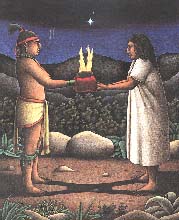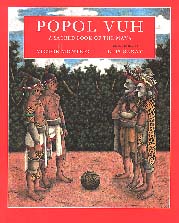|
________________
CM . . . .
Volume VI Number 17 . . . . April 28, 2000
excerpt: B'alam Ki'tze' and B'alam Aq'ab' were pleased with the fire Tojil gave them. But a huge downpour followed, putting out the fires of all the tribes. Once more B'alam' Ki'tze' and B'alam Aq'ab' asked Tojil for fire and again he gave it to them as a gift. But the other tribes were freezing to death. They came to ask B'alam Ki'tze', B'alam Aq'ab', Majukutaj and Iq' B'alam for fire, but they were not well received.  Reviewed from prepublication copy.
Reviewed from prepublication copy.Known as the Sacred Book or the Bible of the Maya K'iche', Popol Vuh was discovered by a young man in 1558, and later, in 1701, it was translated into Spanish by Father Francisco Ximenez, a priest. The sacred document, whose stories stretch over several thousand years, traces the origin of the earth and its people and the progression of the Mayans in Guatemala. The book is divided into four main sections. In the first section, the creation of the earth, water, plants, animals and people is explained. The second (and largest) part consists of mythical tales that were said to have happened before the creation of mankind. At that time, demi-gods and supernatural beings quarreled. Eventually, the Underworld Lords were defeated. It is interesting to note that some of the same themes of the Popol Vuh are found in the Christian Bible - the story of the forbidden fruit is one example. Part Three describes the creation of the "men of corn" (humans) fashioned of cornmeal by Makers Tepew and Q'uk'umetz and blessed with intelligence and the ability to see everything on earth. However, the Makers decided that these qualities made the humans too god-like, and so, the humans' powers of wisdom and knowledge were destroyed. This section also tells of how the world's tribes and nations came to be, all of them sharing one language for a time. The fourth section lists the genealogy of the K'iche kings up to the arrival of the Spanish conquistadors. Of great historical significance, the text of the Popol Vuh celebrates the richness of the ancient Mayan culture. This particular adaptation was written, translated, illustrated, edited and published by people whose roots lie in Guatemala. Though author Montejo intended the book to be for children, much of the language (and the reading level) is too difficult. There are a great many Mayan names in each story, and even with a five-page glossary - a veritable who's who of Mayan gods, demi-gods and heroes - the names often get in the way of the reading. (It would have been beneficial to have each name in the glossary followed by its phonetic spelling.) Luis Garay spent six months in Guatemala researching this work. His paintings, all full-page or double-page spreads, are simple, yet detailed. They have an interesting light quality which is very effective in breathing life into the paintings. Greens and browns of the Guatemalan landscape contrast with the bright colours of the people's clothing and headdresses. Garay's illustrations, which occur only every few pages, are a welcome break from pages of small text. This book is too difficult for weaker readers and would, perhaps, work best as a read-aloud. Recommended with Reservations. Gail Hamilton is a teacher-librarian at Bird's Hill School in East St. Paul, MB.
To comment on this title or this review, send mail to cm@umanitoba.ca.
Copyright © the Manitoba Library Association.
Reproduction for personal use is permitted only if this copyright notice
is maintained. Any other reproduction is prohibited without
permission.
Published by
TABLE OF CONTENTS FOR THIS ISSUE - April 28, 2000.
AUTHORS |
TITLES |
MEDIA REVIEWS |
PROFILES |
BACK ISSUES |
SEARCH |
CMARCHIVE |
HOME
|
